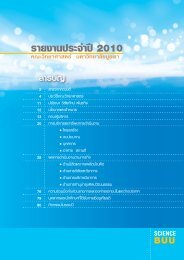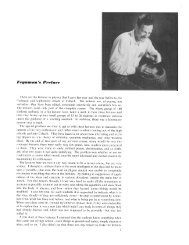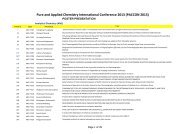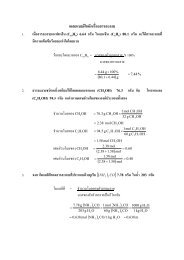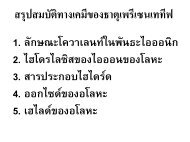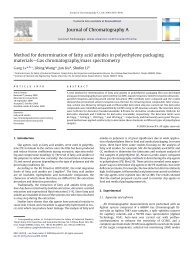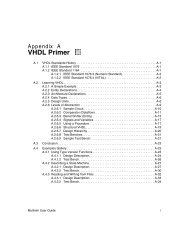USER MANUAL SWAN Cycle III version 40.72A
USER MANUAL SWAN Cycle III version 40.72A
USER MANUAL SWAN Cycle III version 40.72A
Create successful ePaper yourself
Turn your PDF publications into a flip-book with our unique Google optimized e-Paper software.
General definitions and remarks 15<br />
• Only the lowest frequency and the number of frequencies can be chosen. The highest<br />
frequency will be computed by <strong>SWAN</strong> such that ∆f = 0.1 f. This resolution is<br />
required by the DIA method for the approximation of nonlinear 4-wave interactions<br />
(the so-called quadruplets).<br />
• Only the highest frequency and the number of frequencies can be chosen. The lowest<br />
frequency will be computed by <strong>SWAN</strong> such that ∆f = 0.1 f. This resolution is<br />
required by the DIA method for the approximation of nonlinear 4-wave interactions.<br />
• Only the lowest frequency and the highest frequency can be chosen. The number of<br />
frequencies will be computed by <strong>SWAN</strong> such that ∆f = 0.1 f. This resolution is<br />
required by the DIA method for the approximation of nonlinear 4-wave interactions.<br />
The value of lowest frequency must be somewhat smaller than 0.7 times the value of the<br />
lowest peak frequency expected. The value of highest frequency must be at least 2.5 to 3<br />
times the highest peak frequency expected. For the XNL approach, however, this should<br />
be 6 times the highest peak frequency. Usually, it is chosen less than or equal to 1 Hz.<br />
<strong>SWAN</strong> has the option to make computations that can be nested in WAM or WAVE-<br />
WATCH <strong>III</strong>. In such runs <strong>SWAN</strong> interpolates the spectral grid of WAM or WAVEWATCH <strong>III</strong><br />
to the (user provided) spectral grid of <strong>SWAN</strong>. The WAM <strong>Cycle</strong> 4 source term in <strong>SWAN</strong> has<br />
been retuned for a highest prognostic frequency (that is explicitly computed by <strong>SWAN</strong>) of<br />
1 Hz. It is therefore recommended that for cases where wind generation is important and<br />
WAM <strong>Cycle</strong> 4 formulations are chosen, the highest prognostic frequency is about 1 Hz.<br />
In directional space, the directional range is the full 360 o unless the user specifies a limited<br />
directional range. This may be convenient (less computer time and/or memory space), for<br />
example, when waves travel towards a coast within a limited sector of 180 o . The directional<br />
resolution is determined by the number of discrete directions that is provided by the user.<br />
For wind seas with a directional spreading of typically 30 o on either side of the mean wave<br />
direction, a resolution of 10 o seems enough whereas for swell with a directional spreading<br />
of less than 10 o , a resolution of 2 o or less may be required. If the user is confident that no<br />
energy will occur outside a certain directional sector (or is willing to ignore this amount<br />
of energy), then the computations by <strong>SWAN</strong> can be limited to the directional sector that<br />
does contain energy. This may often be the case of waves propagating to shore within a<br />
sector of 180 o around some mean wave direction.<br />
It is recommended to use the following discretization in <strong>SWAN</strong> for applications in coastal<br />
areas:<br />
direction resolution for wind sea<br />
direction resolution for swell<br />
frequency range<br />
spatial resolution<br />
∆θ = 15 o − 10 o<br />
∆θ = 5 o − 2 o<br />
0.04 ≤ f ≤ 1.00 Hz<br />
∆x, ∆y = 50 − 1000 m





